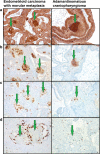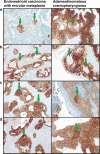Does endometrial morular metaplasia represent odontogenic differentiation?
- PMID: 33666744
- PMCID: PMC8448715
- DOI: 10.1007/s00428-021-03060-2
Does endometrial morular metaplasia represent odontogenic differentiation?
Abstract
The nature of endometrial morular metaplasia (MorM) is still unknown. The nuclear β-catenin accumulation and the not rare ghost cell keratinization suggest a similarity with hard keratin-producing odontogenic and hair matrix tumors rather than with squamous differentiation. We aimed to compare MorM to hard keratin-producing tumors. Forty-one hard keratin-producing tumors, including 26 hair matrix tumors (20 pilomatrixomas and 6 pilomatrix carcinomas) and 15 odontogenic tumors (adamantinomatous craniopharyngiomas), were compared to 15 endometrioid carcinomas with MorM with or without squamous/keratinizing features. Immunohistochemistry for β-catenin, CD10, CDX2, ki67, p63, CK5/6, CK7, CK8/18, CK19, and pan-hard keratin was performed; 10 cases of endometrioid carcinomas with conventional squamous differentiation were used as controls. In adamantinomatous craniopharyngiomas, the β-catenin-accumulating cell clusters (whorl-like structures) were morphologically similar to MorM (round syncytial aggregates of bland cells with round-to-spindled nuclei and profuse cytoplasm), with overlapping squamous/keratinizing features (clear cells with prominent membrane, rounded squamous formations, ghost cells). Both MorM and whorl-like structures consistently showed positivity for CD10 and CDX2, with low ki67; cytokeratins pattern was also overlapping, although more variable. Hard keratin was focally/multifocally positive in 8 MorM cases and focally in one conventional squamous differentiation case. Hair matrix tumors showed no morphological or immunophenotypical overlap with MorM. MorM shows wide morphological and immunophenotypical overlap with the whorl-like structures of adamantinomatous craniopharyngiomas, which are analogous to enamel knots of tooth development. This suggests that MorM might be an aberrant mimic of odontogenic differentiation.
Keywords: CTNNB1; Endometrial; Endometrioid; Morula; Squamous.
© 2021. The Author(s).
Conflict of interest statement
The authors declare no competing interests.
Figures





References
-
- Brachtel EF, Sánchez-Estevez C, Moreno-Bueno G, Prat J, Palacios J, Oliva E. Distinct molecular alterations in complex endometrial hyperplasia (CEH) with and without immature squamous metaplasia (squamous morules) Am J Surg Pathol. 2005;29(10):1322–1329. doi: 10.1097/01.pas.0000171001.87599.e2. - DOI - PubMed
-
- Blanco LZ, Jr, Heagley DE, Lee JC, Gown AM, Gattuso P, Rotmensch J, Guirguis A, Dewdney S, Bitterman P. Immunohistochemical characterization of squamous differentiation and morular metaplasia in uterine endometrioid adenocarcinoma. Int J Gynecol Pathol. 2013;32(3):283–292. doi: 10.1097/PGP.0b013e31826129e1. - DOI - PubMed
Publication types
MeSH terms
Substances
LinkOut - more resources
Full Text Sources
Other Literature Sources
Medical
Research Materials
Miscellaneous

